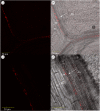Horizontal transmission of the insect symbiont Rickettsia is plant-mediated
- PMID: 22113034
- PMCID: PMC3297456
- DOI: 10.1098/rspb.2011.2095
Horizontal transmission of the insect symbiont Rickettsia is plant-mediated
Abstract
Bacteria in the genus Rickettsia, best known as vertebrate pathogens vectored by blood-feeding arthropods, can also be found in phytophagous insects. The presence of closely related bacterial symbionts in evolutionarily distant arthropod hosts presupposes a means of horizontal transmission, but no mechanism for this transmission has been described. Using a combination of experiments with live insects, molecular analyses and microscopy, we found that Rickettsia were transferred from an insect host (the whitefly Bemisia tabaci) to a plant, moved inside the phloem, and could be acquired by other whiteflies. In one experiment, Rickettsia was transferred from the whitefly host to leaves of cotton, basil and black nightshade, where the bacteria were restricted to the phloem cells of the plant. In another experiment, Rickettsia-free adult whiteflies, physically segregated but sharing a cotton leaf with Rickettsia-plus individuals, acquired the Rickettsia at a high rate. Plants can serve as a reservoir for horizontal transmission of Rickettsia, a mechanism which may explain the occurrence of phylogenetically similar symbionts among unrelated phytophagous insect species. This plant-mediated transmission route may also exist in other insect-symbiont systems and, since symbionts may play a critical role in the ecology and evolution of their hosts, serve as an immediate and powerful tool for accelerated evolution.
Figures




References
-
- Hunter M. S., Zchori-Fein E. 2006. Inherited bacteroidetes symbionts in arthropods. In Insect Symbiosis (eds Bourtzis K., Miller T.), pp. 39–56 Boca Raton, FL: CRC Press
-
- Moran N. A., McCutcheson J. P., Nakabachi A. 2008. Genomics and evolution of heritable bacterial symbionts. Annu. Rev. Genet. 42, 165–19010.1146/annurev.genet.41.110306.130119 (doi:10.1146/annurev.genet.41.110306.130119) - DOI - DOI - PubMed
-
- Vavre F., Fleury F., Lepetit D., Fouillet P., Bouletreau M. 1999. Phylogenetic evidence for horizontal transmission of Wolbachia in host–parasitoid associations. Mol. Biol. Evol. 16, 1711–1723 - PubMed
-
- Werren J. H., Zhang W., Guo L. R. 1995. Evolution and phylogeny of Wolbachia-reproductive parasites of arthropods. Proc. R. Soc. Lond. B 261, 55–6310.1098/rspb.1995.0117 (doi:10.1098/rspb.1995.0117) - DOI - DOI - PubMed
-
- Chiel E., Zchori-Fein E., Inbar M., Gottlieb Y., Adachi-Hagimori T., Kelly S. E., Asplen M. K., Hunter M. S. 2009. Almost there: transmission routes of bacterial symbionts between trophic levels. PLoS ONE 4, e4767.10.1371/journal.pone.0004767 (doi:10.1371/journal.pone.0004767) - DOI - DOI - PMC - PubMed
Publication types
MeSH terms
Substances
LinkOut - more resources
Full Text Sources

